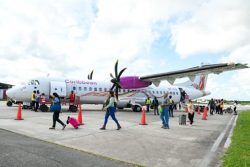Currently producing a total of 380,000 barrels of oil per day (bpd) from the Liza Destiny and Lisa Unity FPSOs in the Stabroek Block, ExxonMobil plans to optimise operations and further ramp up production to 400,000 bpd, some 60,000 bpd more than originally planned, the company’s Vice President (Upstream), Liam Mallon, yesterday announced.
“We have two state-of-the-art floating production storage vessels, the Des-tiny and Unity, producing 380,000 barrels per day with exceptional safety and reliability. By the way, that is 40,000 bpd above the designed capacity,” Mallon disclosed during an address on the first day of the Guyana Energy Con-ference, currently being held at the Marriott Hotel in Georgetown.
“With further de-bottlenecking, we think we can reach 400,000 barrels per day here, in the foreseeable future,” The added.
The company’s Media Relations Advisor, Kwesi Isles, told the Stabroek News that the increase was safe. “Safety is a core value of ExxonMobil operations. We do not compromise safety standards to improve profits. That includes production ramp up,” Isles said.
“All increases are preceded by engineering assessments, which are reviewed with the relevant regulatory authorities,” he added.
Mallon who has worked around the world in the sector for over 40 years, said that in Guyana, the oil potential, developments, and transition, in a short timeframe was unlike anything he has seen. “I have never seen anything quite like this.”
He assured locals that the company was committed to not only generating returns for its shareholders, but is equally interested in seeing holistic development here and that its investments benefit the Guyanese people.
“We at ExxonMobil are convinced that it is not a question of either or. It is an ‘and’ approach. We are demonstrating today that it is possible to grow production and at the said time create value for society and our shareholders, and at the same time lower our emissions.”
Here in Guyana, he said that the company was demonstrating that it plays a leading role in the economic transition and local content, and he repeated the data on input.
Looking to the future, Mallon predicted that in the next four years, Guyana will reach the company’s 1.2 million bpd production target with the planned six FPSOs by then, keeping up the unprecedented pace set.
“In total we anticipate having six projects online with capacity of more than 1.2 million bpd by the end of 2027. It is just not about pace,” he said echoing similar statements by the company’s chairman, Darren Woods, earlier this month.
Woods had said that Guyana continues to feature as its premium investment and that the company expects to bring its third oil platform online earlier than anticipated.
“We’re making really good progress. As we’ve said, we brought Liza 2 in ahead of schedule. We anticipate bringing Payara in ahead of schedule. We brought Liza 2 up very well, brought that online quickly, and began producing at above-nameplate capacity in the fourth quarter. And so, I feel really good about the quality of those projects and the operational ability to bring those up and run them effectively, making good progress there. We’ve got Yellowtail in for government approval. I expect that to be a bigger FPSO.”
Woods iterated that the company’s position has always been one of having a “win-win-win proposition” across the board, as there “needs to be a win for the company. It needs to be a win for the Government of Guyana, and it needs to be a win for the people of Guyana.”
Overall, the chairman noted that the company was ahead of schedule and ahead of the expectations that it has talked about, historically, with Guyana.
“The resource base, as you know, continues to grow. We continue to make discoveries. We continue to really optimize around those discoveries. And that’s a really big part of developing these projects… as we are in parallel to developing projects, continuing the exploration and continuing to better quantify and qualify that resource base is making sure that our projects are optimized around that. So, there’s a balance that we’re striking around how best to optimize, and feel good about what we’re doing there. And, frankly, I think the government feels really good about what we’re doing there. Importantly, the development of that resource and the value associated with that is manifesting itself in country, which is a really important part of the equation here,” Woods noted.
Guyana, Woods said, allows the company to continue to strengthen its industry-leading portfolio and increase production from the “high-return advantaged assets” here, “at a time when the world needed it most.”
Guyana’s outlook has been played up by all the partners in the offshore Stabroek Block, with Hess Corporation (Hess), last week announcing that this country along with North Dakota’s Bakken (USA) area will see some 80 per cent of its US$3.7 billion capital projects-spending committed to them.
Hess’s President, John Hess, shared a similar view. “It is a remarkable achievement that the country is already producing more than 380,000 barrels per day of some of the highest value low carbon crude oil in the world, with a line of sight to be producing over 1.2 million barrels per day by 2027.”
He said that be believes that this country will one day become one of the largest producers of oil and that the contributions from Hess will all be positive.






